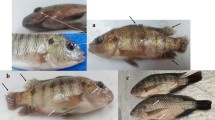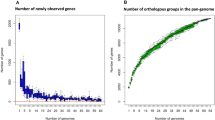Abstract
Purpose
This study aimed to investigate the diversity of Balantioides coli (B. coli) based on the 18S rDNA of isolates collected from weaned pigs with diarrhea and then select a B. coli isolate to determine its pathogenicity in weaned pigs through experimental infection.
Methods
The genetic analysis of field-isolated B. coli strains was based on sequencing of the partial 18S rDNA genetic fragment and the pathogenicity of an isolate of B. coli (DN2018-2-DTD) was identified through an experimental infection.
Results
The fourteen B. coli isolates shared 98.47–100% nucleotide similarity and were divided into two clades in a phylogenetic tree. In an infection experiment, a slight increase in the body temperature was identified in two infected groups as compared to that in the control group (P < 0.05) from days post-infection (dpi) 12–18 and from dpi 20–27. In the group infected with 3000 CPG/TPG, 2/9 pigs started to develop diarrhea on day two. In the group infected with 500 CPG/TPG, 8/9 pigs had diarrhea on dpi 3. Trophozoites/cysts of B. coli were firstly detected in feces on dpi 3 in a group of pigs infected with a dose of 3000 CPG/TPG, and CPG/TPG reached its peak at dpi 5 in both groups of infected pigs (35,450 and 13,250 CPG/TPG). There was a significant difference in the bodyweight of the control group (noninfected) as compared to that of the groups of infected pigs on dpi 7 (P < 0.05), 14 (P < 0.001) and 28 (P < 0.01). Lesions were solely recorded in infected pigs, including white ulcerative nodules with necrosis scattered in the mucosa of the colon and cecum on dpi 7, 14, and 28.
Conclusion
This is the first study to investigate the pathogenicity of B. coli in Vietnamese pigs to demonstrate that B. coli could induce necrotic ulcerative enteritis and diarrhea in weaned pigs.





Similar content being viewed by others
Data Availability
The data that support the findings of this study are available from the corresponding author upon reasonable request.
References
Schuster FL, Ramirez-Avila L (2008) Current world status of Balantidium coli. Clin Microbiol Rev 21(4):626–638. https://doi.org/10.1128/CMR.00021-08
da Silva BA, Ponce-Gordo F, Dib LV, Antunes Uchoa CM, Bastos OMP, Pissinatti A et al (2017) First molecular characterization of Balantioides coli (Malmsten, 1857) isolates maintained in vitro culture and from feces of captive animals, Rio de Janeiro, Brazil. Vet Parasitol Reg Stud Rep 10:102–113. https://doi.org/10.1016/j.vprsr.2017.08.014
Giarratana F, Muscolino D, Taviano G, Ziino G (2012) Balantidium coli in pigs regularly slaughtered at abattoirs of the province of Messina: hygienic observations. Open J Vet Med 2(2):77–80. https://doi.org/10.4236/ojvm.2012.22013
Baskerville L, Ahmed Y, Ramchand S (1970) Balantidium colitis. Report of a case. Am J Dig Dis 15(8):727–731. https://doi.org/10.1007/BF02235994
Cho HS, Shin SS, Park NY (2006) Balantidiasis in the gastric lymph nodes of Barbary sheep (Ammotragus lervia): an incidental finding. J Vet Sci 7(2):207–209. https://doi.org/10.4142/jvs.2006.7.2.207
Dorfman S, Rangel O, Bravo LG (1984) Balantidiasis: report of a fatal case with appendicular and pulmonary involvement. Trans R Soc Trop Med Hyg 78(6):833–834. https://doi.org/10.1016/0035-9203(84)90036-1
Knight R (1978) Giardiasis, isosporiasis and balantidiasis. Clin Gastroenterol 7(1):31–47 (PMID: 627102)
Ladas SD, Savva S, Frydas A, Kaloviduris A, Hatzioannou J, Raptis S (1989) Invasive balantidiasis presented as chronic colitis and lung involvement. Dig Dis Sci 34(10):1621–1623. https://doi.org/10.1007/BF01537123
Sharma S, Harding G (2003) Necrotizing lung infection caused by the protozoan Balantidium coli. Can J Infect Dis 14(3):163–166. https://doi.org/10.1155/2003/829860
Ahmed A, Ijaz M, Ayyub RM, Ghaffar A, Ghauri HN, Aziz MU et al (2020) Balantidium coli in domestic animals: an emerging protozoan pathogen of zoonotic significance. Acta Trop 203:105298. https://doi.org/10.1016/j.actatropica.2019.105298
Ismail HA, Jeon HK, Yu YM, Do C, Lee YH (2010) Intestinal parasite infections in pigs and beef cattle in rural areas of Chungcheongnam-do Korea. Korean J Parasitol 48(4):347–349. https://doi.org/10.3347/kjp.2010.48.4.347
Hindsbo O, Nielsen CV, Andreassen J, Willingham AL, Bendixen M, Nielsen MA et al (2000) Age-dependent occurrence of the intestinal ciliate Balantidium coli in pigs at a Danish Research Farm. Acta Vet Scand 41(1):79–83. https://doi.org/10.1186/BF03549657
Weng YB, Hu YJ, Li Y, Li BS, Lin RQ, Xie DH et al (2005) Survey of intestinal parasites in pigs from intensive farms in Guangdong Province People’s Republic of China. Vet Parasitol 127(3–4):333–336. https://doi.org/10.1016/j.vetpar.2004.09.030
Lai M, Zhou RQ, Huang HC, Hu SJ (2011) Prevalence and risk factors associated with intestinal parasites in pigs in Chongqing China. Res Vet Sci 91(3):e121–e124. https://doi.org/10.1016/j.rvsc.2011.01.025
Bauri RK, Ranjan R, Deb AR, Ranjan R (2012) Prevalence and sustainable control of Balantidium coli infection in pigs of Ranchi Jahrkahnd India. Vet World 5(2):94–99. https://doi.org/10.5455/vetworld.2012.94-99
Duong TM, Do DT, Tat TN (2014) A survey of infection intensity and various entero-sites invasion due to B. coli in weaning piglets at several farms in Southern Provinces, Vietnam. In: 23rd IPVS congress Mexico; Cancun, Mexico 2014
Nguyen HP, Luong ATH, Nguyen HTH, Nguyen TT, Do DT et al (2018) Evaluation of pathogenicity of Balantidium coli in weaned pigs collected from several pig farms in Southern, Vietnam. In: International Pig Veterinary Society Congress; ChongQing, China
Do DT, Luong ATH, Nguyen HTH, Nguyen TT (2019) Evaluation of pathogenicity of Balantidium coli protozoa in post-weaning pigs in some southern provinces. J Vet Sci Technol XXVI(1):62–69
Barbosa Ada S, Bastos OM, Uchoa CM, Pissinatti A, Ferreira Filho PR, Dib LV et al (2015) Isolation and maintenance of Balantidium coli (Malmsteim, 1857) cultured from fecal samples of pigs and non-human primates. Vet Parasitol 210(3–4):240–245. https://doi.org/10.1016/j.vetpar.2015.03.030
Barbosa ADS, Cardozo ML, Dib LV, Fonseca ABM, Uchoa CMA, Bastos OMP et al (2018) Comparative study of three xenic media culture for cultivation of Balantidium coli strains. Rev Bras Parasitol Vet 27(1):20–26. https://doi.org/10.1590/S1984-29612017075
Walsh PS, Metzger DA, Higuchi R (1991) Chelex 100 as a medium for simple extraction of DNA for PCR-based typing from forensic material. Biotechniques 10(4):506–513 (PMID 23599926)
Nilles-Bije ML, Rivera WL (2010) Ultrastructural and molecular characterization of Balantidium coli isolated in the Philippines. Parasitol Res 106(2):387–394. https://doi.org/10.1007/s00436-009-1673-9
Nguyen AHL, Nguyen DN, Nguyen TT, Do DT (2017) Optimizing the PCR protocol to detect Balantidium coli infeccted in pigs. J Agric Sci Techchnol 3:20–28
Szczotka A, Pejsak Z (2013) Balantidium coli in PMWS-suspected Pigs. J Comp Pathol 148(1):82. https://doi.org/10.1016/j.jcpa.2012.11.144
Acknowledgements
The authors also express thank to personnels from Veterinary Hospital of Nong Lam University who support hugely for the study. The study was also carried out over 9 months long by a few students of Faculty of Animal Science and Veterinary Medicine – Nong Lam University, Thu Duc district, Hochiminh city, Vietnam.
Funding
This research was supported by fund of Nonglam Universitty through science and technology project (Study Protocol # CS-CB16-CNTY-01).
Author information
Authors and Affiliations
Contributions
Conceived of or designed study: DTD, NNH. Performed research: DTD, DTM, NMN. Analyzed data: NMN, NLDP. Contributed new methods or models: NMN, DTD, NNH. Wrote the paper: DTD, DTM, NMN.
Corresponding authors
Ethics declarations
Conflict of Interest
The authors declare no conflict of interest.
Ethics Approval
All the procedures were carried out in full compliance with the recommendations in the guidelines of Nonglam University Animal Ethics Committee (AEC), Nonglam University, Vietnam (NLU-191201).
Additional information
Publisher's Note
Springer Nature remains neutral with regard to jurisdictional claims in published maps and institutional affiliations.
Supplementary Information
Below is the link to the electronic supplementary material.
Rights and permissions
About this article
Cite this article
Do , .T., Duong , .T., Nguyen , .M. et al. Phylogenetics and Pathogenicity of Balantioides coli Isolates in Vietnamese Weaned Pigs. Acta Parasit. 67, 110–119 (2022). https://doi.org/10.1007/s11686-021-00418-z
Received:
Accepted:
Published:
Issue Date:
DOI: https://doi.org/10.1007/s11686-021-00418-z




